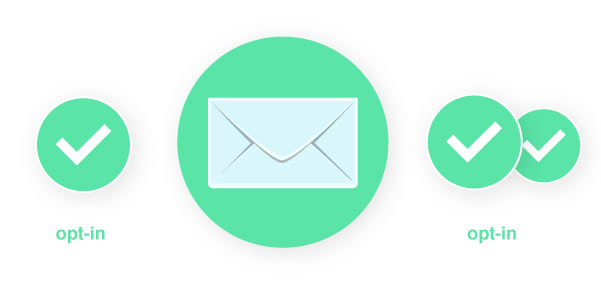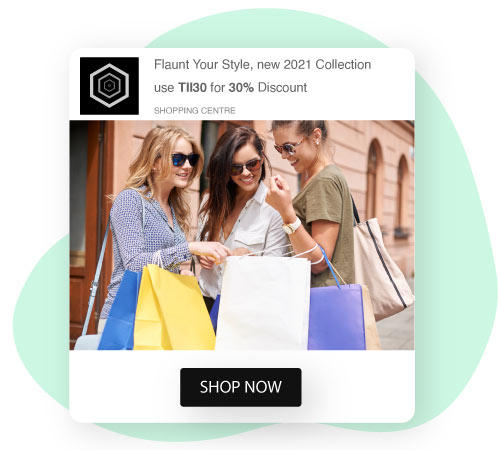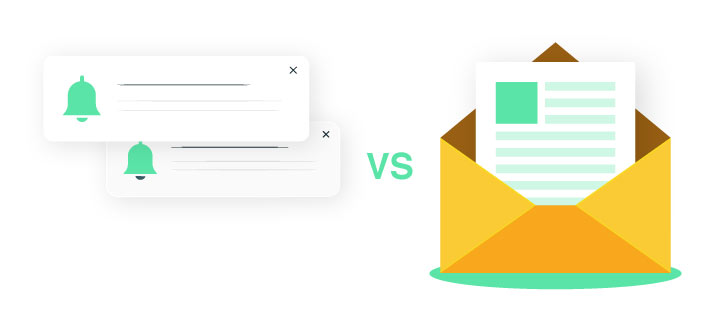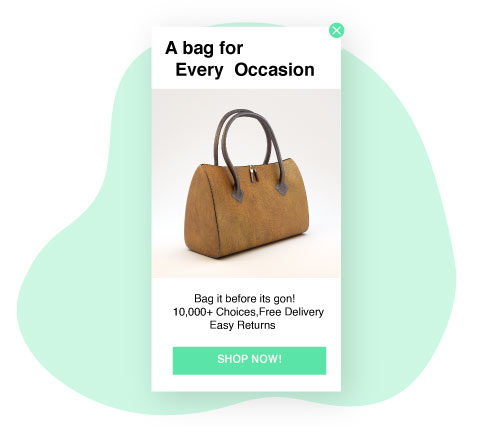Push notifications are used extensively by marketers nowadays. With the current technological advancements allowing their high-level personalization and inclusion of action buttons and media, they are employed to make updates, convey information, send reminders, motivate users to engage with an app, etc.
While push notifications enable you to reach users on mobile devices, laptops, and desktops, thoughtless sending can end up in users uninstalling your app entirely. Here are 41 web push notifications stats that marketers need to know.
These give you reliable figures on who sends them, the kinds of notifications users like to receive, the best times to send them, and ways to improve engagement and CTR. So, read on.
Why Marketers Find Web Push to be Advantageous?
1. Short attention span: Current studies show that the average internet user’s attention span is only 8 seconds. Push notifications let marketers address this challenge with their small ad formats. This, in turn, helps in increasing the CTRs.
2. Resistance to ad blockers: People have widely resorted to using ad blockers nowadays. 615 million devices are using these. However, these do not have any effect on push notification delivery. This gives another advantage to marketers.
3. More smartphone usage: 80% of people online are on smartphones and open marketing messages through it. Marketers make full use of this. No wonder many subscribe to web push notifications through mobile devices.
4. Wide reach: Push notifications can reach people through both desktop computers and mobile devices. Operating systems including macOS, Android, Windows, and browsers, including Opera, Firefox, Chrome, Safari, and Yandex support push notifications. So, push notifications can reach 80% of internet users.
5. High delivery rate: The average deliverability of web pushes is 80%. It depends on the device used by the receiver. It is some 20 to 30% for desktop devices and 50 to 60% for smartphones.
6. Higher ROI and traffic: Push notification can generate high ROI for businesses. It can bring you an ROI of up to 2200% and increase your daily traffic by up to 25%.
7. Less time investment: Marketers need no more than 5 minutes to develop an effective web push notification marketing strategy. And it takes only 1 hour to reach nearly 50% of all clicks in an average campaign. Further, to begin using an integrated web push automation system’s full functionality, you need only one day.
Effectiveness of Web Push Notifications
1. Subscription rate: Subscription levels to web push notifications vary across industries. The average subscription rate is 0.5 to 15% depending upon the industry.

2. Devices used: Subscriptions to web push occur mostly (60%) through mobile phones. The remaining 40% is shared among desktops and tablets, as 30 and 10% respectively.
3. Most popular browser: The most popular browser for web push notifications is Chrome. It accounts for a big 90% of push subscribers.
4. Increased sign-ups with single opt-in: Single opt-in, also known as one-click sign-ups, has been seen to increase the sign-ups by 600%.

5. Disenrollment: Soon after receiving the first notification, only 0.1% of people resort to unsubscribing to your notifications.
6. Increasing CTR: The overall CTR for web push campaigns is 12%. By employing automation, it can be increased up to 15%. And by using rich media, it can be increased by another 3%. Highly targeted and transactional campaigns can have a CTR of up to 30%.
7. Abandoned cart pushes: When push notifications are sent to notify customers of their abandoned carts, it brought an average CTR of 16%.
8. Re-engagement rate: When push notifications were sent to subscribers who were absent for a long site from the site, it brought a CTR of 13%. Facebook increased its number of returning customers by 20% after implementing a web push.
9. Recently-viewed items campaigns: When e-commerce sites send automated push campaigned focusing on recently-viewed items, it brought a CTR of 13%.
10. Best push times: The click time was found to be highest in the afternoon till evening 6. Weekends and Wednesdays saw the highest CTRs for push notification campaigns. And the months which brought in new subscribers the most were July and December.
11. CTA buttons: Using the right CTA (Call to Action) buttons can improve campaign outcomes by more than 40%.

12. Reaction rates by industries: The reaction rates to push notifications across industries vary. The highest reaction rates are witnessed by travel (11.3%), finance (9.8%), and eCommerce (7.9%).
13. Reaction rates by continents: The reaction rate to push notifications is highest in Europe (8.5%). This is followed by Asia (8.0), Africa (7.7%), Oceania (7.7%), North America (7.5%), and South America (6.9%).
14. Open rates by industries: The push notification open rates also vary by industry. Business and finance (5.46%), entertainment and events (5.09%), and coupons and deals (4.59%) are the top three rankers. The poorest performers are food and delivery (1%) and retail (0.89%).

Industries Using Web Push Notifications
1. Highest user: The industry that uses web push notifications to the largest extent (22.03%) is e-commerce. 85% of online stores and other e-commerce operations use pushes in their business.
2. Second highest user: The second highest ranked (18.79%) with regards to using push notifications is media, publishing, and blogging. 9% of businesses in this niche use push in their business.
3. Third highest user: The third rank holder (8.35%) is BFSI (Banking, Financial Services, and Insurance).
4. Other high rankers: Other industries using push notifications for their marketing are Software and SaaS (7.62%), Digital marketing agencies (7.52%), Arts, sports, and entertainment (6.89%), Education and e-learning (6.37%), and Healthcare and wellness (5.01%).
5. Least users: The industries that use push notifications the least for their marketing are Directories and Aggregators (2.4%), Travel and Hospitality (2.61%), Careers and Training (2.71%), and Gaming (4.8%).
6. Send times: Different industries have set different timing for sending push notifications. For e-commerce, it is 3 pm to 4 pm on Wednesdays; and for media, publishing, and blogging, it is 9 am to 10 am on Tuesdays; for BFSI, it is 3 pm to 5 pm on Tuesdays; for Software and SaaS, it is 4 pm to 7 pm on Wednesdays; and for Digital Marketing Agencies, it is 2 pm to 7 pm on Tuesdays.
Web Push Vs Newsletter
1. Web push vs newsletter: At least twice as many users subscribe for push notifications compared to newsletters. Besides newsletter, sign-up rates lag far behind web push in terms of performance.

2. CTR: The CTR of push notifications is at least twice higher than that of email marketing.
3. Time-lapse: For your message sent to be seen by the receiver, it takes 6.4 hours in the case of a newsletter. But for push notifications, it is almost instant.
4. Open/view rate: The open/view rate for a newsletter is 15 to 30%, whereas for a push notification it is 45 to 90%.
5. ROI: The ROI for a newsletter is 122%, whereas, for push notification, it is 3500%.

Ways to Improve Web Push Notification Campaign Performance
- Segmentation: Sending generalized messages to your entire user base doesn’t result in higher conversions. By segmenting your user base, you can send them highly personalized messages. Currently, only 20% of pushes are segmented.

2. Personalization: Personalization can increase reaction rates fourfold. Certain personalization aspects perform better than others. One of those is stated preferences.

3. Advanced feature usage: Usage of advanced push notification features can improve the performance of campaigns. Features like smart campaigns, multi-website, welcome drips and expiry scheduling are used in 11.48%, 13.11%, 34.43%, and 54.10% push notifications.
4. Usefulness: Though 50% of users like to receive push notifications, only 18% of them find all of them useful. By increasing the value offered by your messages, you can help improve the performance of your campaigns.
5. Tailored send times: Tailoring the send time of your push notifications to suit each of your recipients’ convenience will increase the reaction rates by 40%.
6. Rich media usage: As mentioned earlier, the usage of rich media increases CTR. However, only 8% of marketers make use of these.

7. Use emojis: People tend to click through and open push notifications with emojis. The inclusion of these can increase CTR by 4.94%. Some of the best performing emojis are two hearts, hearts in love, and the ‘see no evil monkey.
8. A/B testing: A/B tested push notifications bring a 10% higher CTR than those sent without carrying it out. So, A/B test your pushes before sending them.

9. Ideal length: The ideal length of push notification messages differs across industries. It is 55 characters for business and finance; 20 characters for deals and coupons; 25 characters for education and training; 90 characters for entertainment and events, health and fitness, and travel and hospitality; 85 for retail and e-commerce, and 45 characters for food and delivery, media and publishing, and utilities and services.
Final Thoughts
Push notifications are ideal digital channels to reach users. However, they can also disturb and annoy the users, causing them to cancel the subscription. So, marketers need to use these cautiously. Some ways to retain users and improve the performance of campaigns are user segmentation, personalization, usage of advanced features and rich media, A/B testing, tailored send times, focusing on ideal length, and offering value. Hope our web push notifications stats in this regard are useful to our readers.
